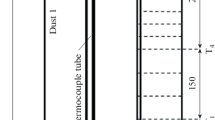Abstract
An investigation was made of the rates of removal of bismuth and lead from molten copper alloys stirred differently under vacuum at 1403 K. The heating conditions, which corresponded to highest, intermediate, and lowest stirring, were referred to as HC-A, HC-B, and HC-C, respectively. The rates of removal were described by a first-order rate equation involving the final concentration of the impurity. The overall mass-transfer coefficient for bismuth or lead (i),K i, was determined, and it was found that Ki(HC-A) > Ki(HC-B) but Ki(HC-B) < Ki(HC-C) in Cu-Bi, Cu-Pb, and Cu-Bi-Pb alloys. In general, it was found that Ki(Cu-Bi-Pb) > Ki(Cu-Bi) or Ki(Cu-Pb). Oxygen reducedK i more than sulfur. The reducing effect of oxygen and sulfur was weakened when stirring rate increased. In vacuum melting of Cu-Bi-Pb-O and Cu-Bi-Pb-S alloys under HC-C,K i tended to decrease with increasing oxygen and sulfur concentrations. The loss of copper indicated that the rates were determined by liquid-phase mass-transfer and evaporation. The liquid-phase mass-transfer coefficient,K L, was calculated, and it was found thatK L(UC- A) > KL(HC-B) but KL(HC-B) < KL(HC-C). The last relation was contrary to current theoretical prediction. A new model was assumed to account for this fact. The observed relative volatility coefficients of bismuth and lead were much smaller than their respective theoretical coefficients. Oxygen and sulfur adsorbed on the surface of the melt were considered to be close to equilibrium with their respective bulk concentrations, and their effects on the evaporation mass-transfer coefficients for bismuth and lead were estimated to be fairly small. This result means that the observed reduction ofK i is due mostly to the decrease inK L and made possible the calculation ofK L. Oxygen decreasedK L more than sulfur. In vacuum melting of Cu-Bi-Pb-O and Cu-Bi-Pb-S alloys under HC-C,K L decreased linearly with increasing oxygen or sulfur concentration. The final concentrations of bismuth and lead in these alloys under HC-C tended to increase with increasing oxygen and sulfur concentrations and tended to decrease with increasingK i andK L.
Similar content being viewed by others
References
M. Kameda and A. Yazawa:Tohoku Daigaku Senko Seiren Kenkyusho Iho, 1963, vol. 19, pp. 57–68.
Reiichi Ohno:Metall. Trans. B, 1976, vol. 7B, pp. 647–53.
R. Harris:Metall. Trans. B, 1984, vol. 15B, pp. 251–57.
E. Ozberk and R.I.L. Guthrie:Metall. Trans. B, 1986, vol. 17B, pp. 87–103.
F.D. Richardson:Physical Chemistry of Melts in Metallurgy, Academic Press, London, 1974, p. 410.
E.S. Machlin:Trans. TMS-AIME, 1960, vol. 218, pp. 314–26.
R. Ohno:Metall. Trans., 1973, vol. 4, pp. 909–15.
R. Ohno, M. Kagawa, and T. Hasumi:Trans. Jpn. Inst. Met., 1973, vol. 14, pp. 140–47.
R. Ohno:Metall. Trans. B, 1982, vol. 13B, pp. 175–84.
R. Ohno:Metall. Trans. B, 1986, vol. 17B, pp. 291–305.
O. Knacke and I.N. Stranski: inProgress in Metal Physics, B. Chalmers and R. King, eds., Pergamon Press, London, 1956, vol. 6, p. 181.
F.D. Richardson:Physical Chemistry of Melts in Metallurgy, Academic Press, London, 1974, p. 486.
M. Olette: inPhysical Chemistry of Process Metallurgy, Part 2, G.R. St. Pierre, ed., Interscience, New York, NY, 1961, pp. 1065–87.
J.F. Elliott and M. Gleiser:Thermochemistry for Steelmaking, Addison-Wesley Publishing Co., Reading, MA, 1960, vol. 1, p. 8.
R. Hultgren, P.D. Desai, D.T. Hawkins, M. Gleiser, K.K. Kelley, and D.D. Wagman:Selected Values of the Thermodynamic Properties of the Elements, ASM, Metals Park, OH, 1973, p. 155.
R. Hultgren, P.D. Desai, D.T. Hawkins, M. Gleiser, K.K. Kelley, and D.D. Wagman:Selected Values of the Thermodynamic Properties of the Elements, ASM, Metals Park, OH, 1973, p. 77.
R. Hultgren, P.D. Desai, D.T. Hawkins, M. Gleiser, K.K. Kelley, and D.D. Wagman:Selected Values of the Thermodynamic Properties of the Elements, ASM, Metals Park, OH, 1973, p. 383.
T. Azakami and A. Yazawa:Nippon Kogyo Kaishi, 1967, vol. 83, pp. 666–72.
A. Yazawa, T. Azakami, and T. Kawashima:Nippon Kogyo Kaishi, 1966, vol. 82, pp. 519–24.
E.T. Turkdogan:Physical Chemistry of High Temperature Technology, Academic Press, New York, NY, 1980, p. 7.
E.T. Turkdogan:Physical Chemistry of High Temperature Technology, Academic Press, New York, NY, 1980, p. 18.
G.R. Rigby and B. Hamilton:J. Am. Ceram. Soc., 1961, vol. 44, pp. 201–5.
K.T. Jacob and C.B. Alcock:J. Am. Ceram. Soc., 1975, vol. 58, pp. 192–95.
F.D. Richardson:Physical Chemistry of Melts in Metallurgy, Academic Press, London, 1974, p. 437.
K. Monma and H. Suto:Nippon Kinzoku Gakkaishi, 1960, vol. 24, pp. 377–79.
K. Monma and H. Suto:Nippon Kinzoku Gakkaishi, 1960, vol. 24, pp. 374–77.
S. Hayakawa, T. Choh, and M. Inouye:Trans. Iron Steel Inst. Jpn., 1982, vol. 22, pp. 637–45.
Shinya Otsuka and Zensaku Kozuka:Metall. Trans. B, 1976, vol. 7B, pp. 147–49.
T. Ejima, N. Inagaki, and M. Kameda:Trans. Jpn. Inst. Met., 1966, vol. 7, pp. 133–42.
K. Mori and M. Sano: inKinetics of Metallurgical Processes in Steelmaking, W. Dahl, K.W. Lange, and D. Papamantelles, eds., Verlag Stahleisen M.B.H., Düsseldorf, Federal Republic of Germany, 1975, pp. 492–512.
F.D. Richardson:Physical Chemistry of Melts in Metallurgy, Academic Press, London, 1974, pp. 436–37.
Author information
Authors and Affiliations
Rights and permissions
About this article
Cite this article
Ohno, R. Kinetics of removal of bismuth and lead from molten copper alloys in vacuum induction melting. Metall Trans B 22, 447–465 (1991). https://doi.org/10.1007/BF02654283
Received:
Issue Date:
DOI: https://doi.org/10.1007/BF02654283




